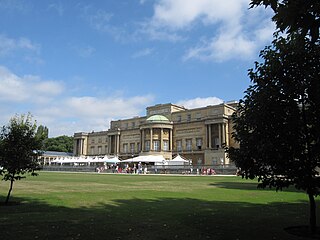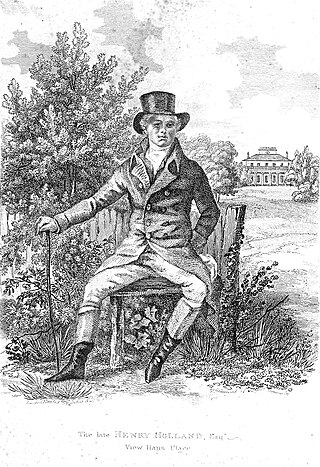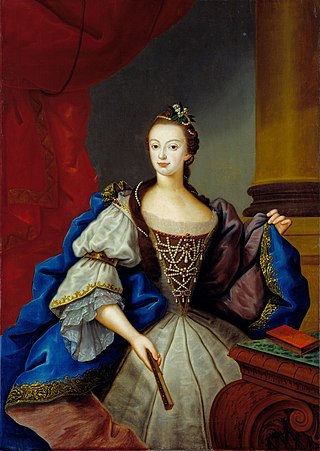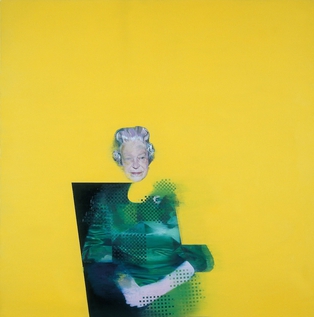
The Yellow Drawing Room is a room in Buckingham Palace. It is noted for its Chinoiserie decorative scheme and has been the setting for many portraits of members of the British royal family.

The Yellow Drawing Room is a room in Buckingham Palace. It is noted for its Chinoiserie decorative scheme and has been the setting for many portraits of members of the British royal family.
The room is at the west end of the Great Gallery on the first floor of the palace and overlooks the forecourt. [1] The room was created as part of Edward Blore's development of the palace in the 1840s. [1] The Chinese Luncheon Room is at the opposite end, with the Centre Room in between. [2] The room interconnects with a suite of bedrooms and dressing rooms for visitors. [1] The name of the room derives from the amber-coloured satin damask that hung in the room in the 19th century. [3] The room is 32 ft (9.8 m) in height, and is roughly square. [4]
A number of pieces from the Yellow Drawing Room were among 120 objects from Buckingham Palace that were loaned to the Royal Pavilion for two years from September 2019. The pieces were displayed at the pavilion where they had originally been placed after their acquisition by George IV. The pieces were removed from the Yellow Drawing Room during work on the East Wing of Buckingham Palace. [5]

Charles Knight's 1843 guide to London described the room as the "most superb of the whole" of the rooms on the floor and noted that it was decorated with full length portraits of the royal family painted on panels. [6] The Illustrated London News described the room as "the most superb of the entire range of rooms" of the western front of the palace in 1844, and likened its appearance to the drawing room of the Reform Club on Pall Mall. [4] Sculptural reliefs by William Pitts were a feature of the room in the 1840s. A series of twelve reliefs on the "origin and progress of pleasure" decorated the room. The individual reliefs have been described in sequence as depicting; Love Awakening the Soul to Pleasure, the Soul in the Bower of Fancy, the Pleasure of Decoration, the Invention of Music, the Pleasure of Music, the Dance, the Masquerade, the Drama, the contest for the Palm, the Palm resigned, the Struggle for the Laurel and the Laurel obtained. [4] The Illustrated London News regretted the addition of medallion portraits of royal family members that broke up the frieze. [4]
The chandelier in the Yellow Drawing Room was formerly hung in the Music Room of the Royal Pavilion. [7]
The room was redecorated in yellow silk for the visit of French Emperor Napoleon III and his spouse, the Empress Eugénie, in 1855 when it was used as the Emperor's reception room. [3] [1] The couple stayed at Buckingham Palace for three days. [1] The Illustrated London News described the decoration of the room as "incongruous" owing to the addition of the chinoiserie furniture from the Royal Pavilion. [3]
The room contains many objects from the Chinoiserie decorative scheme by Frederick Crace for the Royal Pavilion in Brighton. [8] The Centre Room and Chinese Drawing Room are also decorated in a similar style. [5] The pieces were bought to Buckingham Place after the 1850 sale of the pavilion; and incorporated into rooms at the palace under the direction of Prince Albert. [5]
| External videos | |
|---|---|
The wallpaper in the Yellow Drawing Room was supplied in 1817 for the saloon of the Royal Pavilion, the wallpaper was ordered by George IV, and rediscovered in the palace in the 20th century. It was hung under Queen Mary's redecoration of the room in the 1920s. [9] [1] The wallpaper was removed for conservation in 2020; its removal took a month. Following conservation the wallpaper should not require further care for 100 years. [8] The wallpaper depicts a Chinese garden with birds with distinctive plumages and butterflies as well as fruit trees and shrubs. The decorative scheme of the wallpaper is divided between two borders; the upper has tall green jars and hanging baskets with magnolias and peonies, the lower border features wading birds and tall lotus plants. [7]
The room has a chimney piece in the Chinese style from the Saloon at the Royal Pavilion. It was made by Samuel Parker to a design by Robert Jones in 1822 at a cost of £922 (equivalent to £89,385in 2021). [7] It has nodding mandarins wearing dresses of varnished metal in niches and fearsome winged ormolu dragons. [10] The mounted Chinese celadon candelabra on the fireplace also came from the saloon. [1] The frieze of the mantelpiece depicts two serpents approaching a sunflower with two winged dragons climbing the steel columns that support the mantelpiece. [7]
The Rock Clock on the fireplace was originally situated in the Music Room of the pavilion. [1] Its design has been attributed to Sébastien Slodtz. It depicts a dragon being attacked by Mars wrapped around a rock and palm tree. Juno is atop the dial, with Cupid shown embracing a peacock. [7]
A pair of tables in the chinoiserie style stand either side of the chimney piece. [1] One of the tables is French, and dates from c.1780; it was originally part of the Chinese Room at Carlton House. [1] The other table is English, and is a copy of the French table; it was made for the Music Room Gallery at the Royal Pavilion in 1819 by Edward Bailey. [1] A set of chairs made by Bailey & Sanders in the room were originally situated in the Banqueting Room Gallery at the pavilion. [1]
The room is home to a pair of Chinese pagodas in porcelain on Spode bases. [1] The pagodas sit either side of a pietra dura-topped table made by Morel & Seddon; it was originally intended for Windsor Castle's Crimson Drawing Room. [1] A matching pair of pagodas stood in the Principal Corridor of the palace in the 1930s. [11]
The room has been the setting for numerous portraits of members of the British royal family. Terence Cuneo recalled photographing the four-year-old Prince Charles in the Yellow Drawing Room in 1953 as part of his preparations for the official portrait of the coronation of Elizabeth II. Charles asked to photograph Cuneo in turn, and was hoisted by Cuneo onto a 9-foot (2.7 m) ladder, much to the consternation of Cuneo and his nurse, Nanny Lightbody. [12] Bryan Organ used the room as the setting for his portrait of Diana, Princess of Wales in 1981. [13] Justin Mortimer's 1997 abstract portrait The Queen was commissioned by the Royal Society of Arts. [14] The light artist Chris Levine took 10,000 images in the Yellow Drawing Room of Queen Elizabeth II over two sittings to create his 2004 hologram, Equanimity. This was the first 3D holographic portrait of the Queen. [15] Rolf Harris painted the Queen in the room for his portrait to mark her 80th birthday in 2005. [16] Prince Philip, Duke of Edinburgh posed in the room for his 2012 portrait by painter Jemma Phipps. [17] Darren Baker's 2011 portrait of the Queen in the Yellow Drawing Room was commissioned to mark the 90th anniversary of the Royal British Legion and depicted her wearing five remembrance poppies and showing the time of 11 am on her wristwatch to symbolise the armistice that ended World War I. [18]

Buckingham Palace is a royal residence in London and the administrative headquarters of the monarch of the United Kingdom. Located in the City of Westminster, the palace is often at the centre of state occasions and royal hospitality. It has been a focal point for the British people at times of national rejoicing and mourning.

Osborne House is a former royal residence in East Cowes, Isle of Wight, United Kingdom. The house was built between 1845 and 1851 for Queen Victoria and Prince Albert as a summer home and rural retreat. Albert designed the house himself, in the style of an Italian Renaissance palazzo. The builder was Thomas Cubitt, the London architect and builder whose company built the main facade of Buckingham Palace for the royal couple in 1847. An earlier smaller house on the Osborne site was demolished to make way for the new and far larger house, though the original entrance portico survives as the main gateway to the walled garden.

The Royal Pavilion, and surrounding gardens, also known as the Brighton Pavilion, is a Grade I listed former royal residence located in Brighton, England. Beginning in 1787, it was built in three stages as a seaside retreat for George, Prince of Wales, who became the Prince Regent in 1811, and King George IV in 1820. It is built in the Indo-Saracenic style prevalent in India for most of the 19th century. The current appearance of the Pavilion, with its domes and minarets, is the work of architect John Nash, who extended the building starting in 1815. George IV's successors William IV and Victoria also used the Pavilion, but Queen Victoria decided that Osborne House should be the royal seaside retreat, and the Pavilion was sold to the city of Brighton in 1850.

Sir William Chambers was a Swedish-born British architect. Among his best-known works are Somerset House, and the pagoda at Kew. Chambers was a founder member of the Royal Academy.

Buckingham Palace Garden is a large private park attached to the London residence of the British monarch. It is situated to the rear (west) of Buckingham Palace, occupying a 17-hectare (42-acre) site in the City of Westminster and forms the largest private garden in London. It is bounded by Constitution Hill to the north, Hyde Park Corner to the west, Grosvenor Place to the south-west, and the Royal Mews, Queen's Gallery, and Buckingham Palace itself to the south and east.

Kensington Palace is a royal residence set in Kensington Gardens, in the Royal Borough of Kensington and Chelsea in London, England. It has been a residence of the British royal family since the 17th century, and is currently the official London residence of the Prince and Princess of Wales, the Duke and Duchess of Gloucester, the Duke and Duchess of Kent, Prince and Princess Michael of Kent and Princess Eugenie and her husband Jack Brooksbank and their two sons.

The Catherine Palace is a Rococo palace in Tsarskoye Selo (Pushkin), located 30 kilometres (19 mi) south of St. Petersburg, Russia. It was the summer residence of the Russian tsars. The palace is part of the World Heritage Site Saint Petersburg and Related Groups of Monuments.

The Nymphenburg Palace is a Baroque palace situated in Munich's western district Neuhausen-Nymphenburg, in Bavaria, southern Germany. The Nymphenburg served as the main summer residence for the former rulers of Bavaria of the House of Wittelsbach. Combined with the adjacent Nymphenburg Palace Park it constitutes one of the premier royal palaces of Europe. Its frontal width of 632 m (2,073 ft) even surpasses Versailles.

Chinoiserie is the European interpretation and imitation of Chinese and other East Asian artistic traditions, especially in the decorative arts, garden design, architecture, literature, theatre, and music. The aesthetic of chinoiserie has been expressed in different ways depending on the region. It is related to the broader current of Orientalism, which studied Far East cultures from a historical, philological, anthropological, philosophical, and religious point of view. First appearing in the 17th century, this trend was popularized in the 18th century due to the rise in trade with China and the rest of East Asia.

Carlton House, sometimes Carlton Palace, was a mansion in Westminster, best known as the town residence of King George IV, particularly during the regency era and his time as prince regent. It faced the south side of Pall Mall, and its gardens abutted St James's Park in the St James's district of London. The location of the house, now replaced by Carlton House Terrace, was a main reason for the creation of John Nash's ceremonial route from St James's to Regent's Park via Regent Street, Portland Place and Park Square: Lower Regent Street and Waterloo Place were originally laid out to form the approach to its front entrance.

Henry Holland was an architect to the English nobility.

The Palace of Queluz is an 18th-century palace located at Queluz, a city of the Sintra Municipality, in the Lisbon District, on the Portuguese Riviera. One of the last great Rococo buildings to be designed in Europe, the palace was conceived as a summer retreat for King José I's brother, Pedro of Braganza, later to become husband and king jure uxoris to his own niece, Queen Maria I. It eventually served as a discreet place of incarceration for Maria I, when she became afflicted by severe mental illness in the years following Pedro III's death in 1786. Following the destruction of Ajuda Palace by fire in 1794, Queluz Palace became the official residence of the Portuguese Prince Regent João, and his family, and remained so until the royal family fled to the Portuguese colony of Brazil in 1807, following the French invasion of Portugal.

The Chinese Pavilion, located in the grounds of the Drottningholm Palace park, is a Chinese-inspired royal pavilion originally built between 1753 and 1769. The pavilion is currently one of Sweden's Royal Palaces and a UNESCO World Heritage Site.

The Royal Collection of the British royal family is the largest private art collection in the world.

The Queen is a 1997 portrait by the English painter Justin Mortimer of Queen Elizabeth II. The portrait was commissioned by the Royal Society of the Arts to mark their 50th anniversary of association with the Queen, and hangs in their headquarters. It was officially unveiled in May 1998. The portrait was initially displayed to the public for five days in January 1998 at the Business Design Centre in Islington, north London.

Martin Yeoman is an English painter and draughtsman who drew members of the British Royal Family. He was commissioned to draw the Queen's grandchildren and accompanied Charles, Prince of Wales, on overseas tours as tour artist. He is described as one of the finest draughtsmen working today and is a member of Senior Faculty at the Royal Drawing School.
Millie Chen is Taiwanese-born Canadian artist, educator, and writer. Based in Buffalo, New York, Chen is a professor in the Department of Art at the University at Buffalo.

Diana, Princess of Wales is a 1981 painting of Diana, Princess of Wales, by the British artist Bryan Organ. It was commissioned by the National Portrait Gallery in London following Diana's engagement to Charles, Prince of Wales, in February 1981 while the gallery was under the directorship of John Hayes. It presently hangs as part of the National Portrait Gallery's permanent collection.

Frances Caroline Fairman was a British watercolourist, a painter in oils, and an illustrator. In her lifetime she was best known for her canine portraits, some of which were commissioned by royalty and aristocracy. She was known as "the Lady Landseer" for the quality of her work. She travelled to the Americas, France, and Switzerland, returning with watercolour landscape sketches.

The Great Pagoda at Kew Gardens in southwest London was built in 1761 by Sir William Chambers as a present for Princess Augusta, the founder of the gardens. Constructed of grey brick, the pagoda comprises 10 storeys, totalling 163 ft (50 m) in height, with 253 steps to the viewing gallery. Closed for repairs in 2006, the pagoda was reopened in 2018 following a major programme of restoration. It is a Grade I listed building.